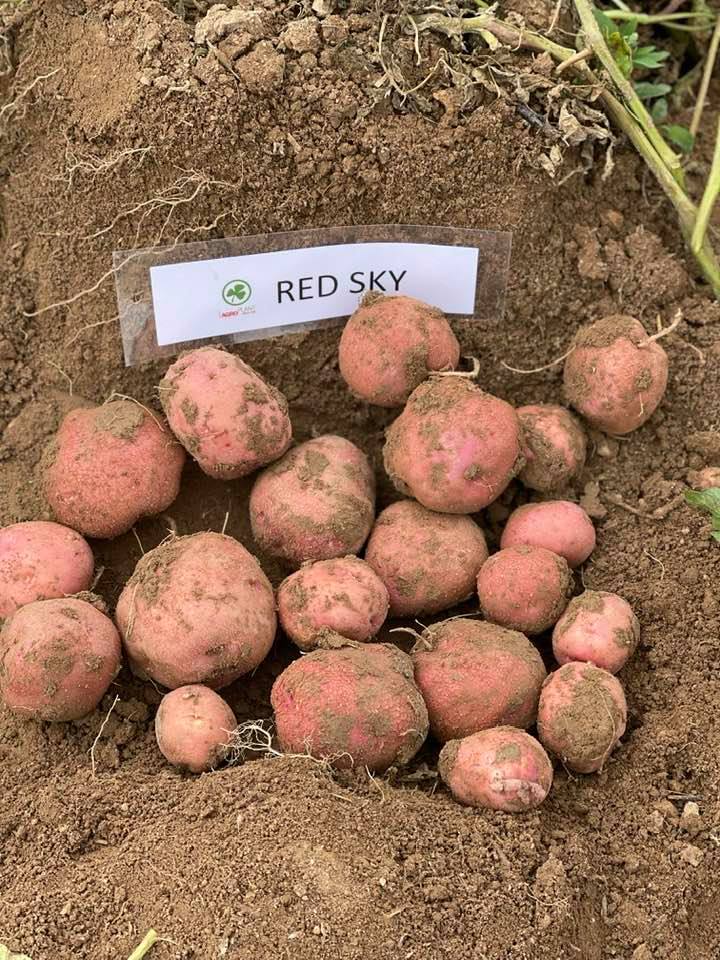Features of RED SKY
RED SKY is a variety of the producer Dutch AGROPLANT B. V, distributed in Spain by VAN RIJN SEEDS S. L. The variety is moderately early, red-skin and yellow flesh clear. Its round shape and its high percentage of dry matter (around 23%), make in a variety suitable for the market of fries (or chips). The production of this variety is high, between 10 and 12 units per floor. The tubers are large, uniform and resistant to unfavourable conditions.
A destacar también su bajo contenido en azucares, lo cual favorece su capacidad para ser almacenada largos periodos sin mermar su calidad. Relacionado con lo anterior, también merece ser destacado su bajo contenido en acrilamida, muy por debajo de lo establecido por la Unión Europea.
The issue of acrylamide, by its connection with the increased risk of suffering from cancer, is under strict control since November 2017, when it was published in Regulation (EU) 2017/2158 of the European Commission, a series of mitigation measures and benchmark levels to reduce the presence of acrylamide in food. This is a problem that deals with the agendas of the World Health Organization (WHO), the United Nations Organization for Food and Agriculture (FAO), the Spanish Agency for Food Safety and Nutrition (AESAN), the European Food Safety authority (EFSA), and of an endless list of relevant organisations concerned with food security and health. So since the publication of the regulations of 2017, we have published more measures, each becoming more restrictive.
Why choose RED SKY?
- Good performance.
- Excellent quality of the fried chips.
- High dry matter content in just 90 days.
- Good storage capacity.
- Low level of sugars.
- Low content of acrylamide.
- Good resistance to late blight.
RED SKY hopes to carve a niche in the market of chips
As we mentioned in a previous publication (“the varieties most commonly used in this sector are generally SOUR, HERMES, LADY ROSETTA, and LADY YELLOW“), it is a sector quite tight, with few variations in terms of the use of varieties. But after the successful tests, carried out in Europe, it is expected that RED SKY get a niche among the varieties are dominant in Spain.
![vintage2 - BE PROFY IN POTATOES NEWS Field test of AGROPLANT Holland (Emmeloord) [Source: Facebook @agroplantbv].](https://patatadesiembra.es/wp-content/uploads/2021/11/campo-de-ensayo-en-holanda-red-sky-agroplant.jpg)
The introduction of an unknown variety is a complicated task. It takes many years to gain the trust of all the figures involved, always on the basis of good results.
The variety RED SKY takes several years to be tested in Spain, obtaining very good results.

Comparison with similar varieties
AGROPLANT has a comparative NETWORK SKY in front of varieties such as LADY ROSETTA, LADY CLAIRE, and HERMES:
| BU 09-524 | LADY ROSETTA | LADY CLAIRE | HERMES | |
| Netherlands | 53,30 T/Ha | 52,00 T/Ha | 46,80 T/Ha | 54,2 T/Ha |
| Greece | 42,00 T/Ha | 38,00 T/Ha | 36,00 T/Ha | – |
| Israel | 74,30 T/Ha | – | – | 68,60 T/Ha |
Comparison of productions in different countries
| BU 09-524 | LADY ROSETTA | LADY CLAIRE | HERMES | |
| October | 8 | 8 | 8 | 7 |
| January | 8 | 5 | 7 | 6 |
| April | 7 | 4 | 7 | 6 |
Comparison of quality of deep-fried chips in different moments of their conservation.
How to develop new varieties?
The processes of research and development of new varieties by the production houses of seed assume important part of its activity. All the production houses of potato planting devote a lot of efforts and a high budget to the search of varieties.
The first steps of the new varieties are formed mainly in the laboratories, where he speculates on different crosses of varieties, depending on the characteristics of the ‘parents’ selected. These crosses are performed in small quantities, and checks to see if the result meets the expectations of the characteristics persecuted.
The crossings successful is repeated over several years. The varieties that are stable, reliable, and promising, are tested in the fields of test. Fields of test in different locations and conditions in order to verify the adaptability and results of the varieties. Also for several years.
![NEDATO, WORLD CLASS POTATOES. PART 1 - BE PROFY IN POTATOES NEWS Fair varieties of potato 2021 AGROPLANT [Source: Facebook @agroplantbv].](https://patatadesiembra.es/wp-content/uploads/2021/11/feria-de-las-variedades-de-agroplant-2021.jpg)
Finally, when a variety has proven its validity, happens to be tested in larger stretches, in multiple locations. Again for several years. This is the only way to do real-world testing to check how they resist changing conditions in terms of temperature, altitude, watering, soil, pests, etc
After a minimum of 10 years, when the variety ensures their suitability, begins its process more complicated: to earn the confidence of the sector.

